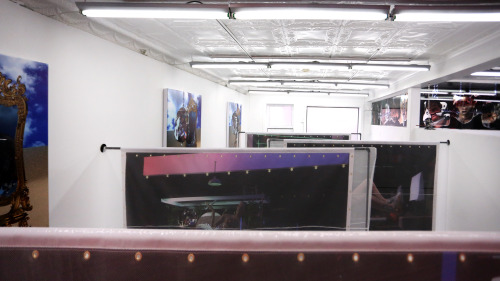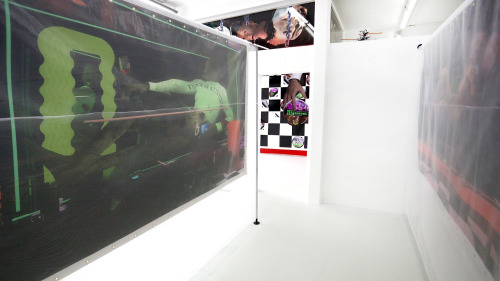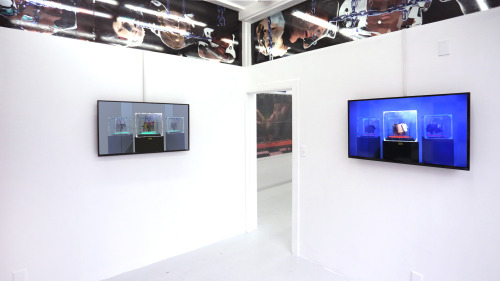
The trouble with talking about decentralized cultures is semi-obvious; the moment you point to any one aspect of the network, the network becomes immaterial. It’s the source of their power. In that inevitable failure, the first thing to be revealed is the myth of objective observation, of the invisible eye. That is moot to anyone invested in identity politics, but while viewing the Wickerham/Lomax Baltimore reboot of Girth Proof (Dem Passwords, Los Angeles, 2015), I find the constant reminder of both notes comforting.
A dense, winding installation inaugurates Springsteen Gallery’s new space, a storefront located across town from their former location in the Copycat Building. Installations in 502 W. Franklin Street’s three connected rooms are multiplied by a labyrinth of four large, mesh covered billboard printouts of CGI male odalisque imagery, dark illuminations of club culture pre and post. The imagery-turned-architecture fragments the gallery into a variety of encounters between TV screens displaying slowly rotating CGI ass purses, framed club paraphernalia references, and a series of Craigslist casted portraits. I navigated the space clumsily while trying to keep track of what I had seen and what I glimpsed around corners.

The accompanying gallery text points to exterior components of the show, including BOY’Dega, the entity that Wickerham and Lomax gave birth to as gay dads (using their own description); clues about the sprawling narrative between depicted scenes; and cooperation with the LED Art Billboard towering over North Charles and Lanvale in an eight day display series of the CGI portraits.
Only in researching these supplements later do I truly feel enveloped by the referenced narrative as name drops lead to dead ends. The embossed name plates of unlabeled phone numbers tease (and remind me of a note found in my backyard: “PUSSY EATER: 410-[XXX]-[XXXX]”) and searches for “non-supplemental” content of BOY’Dega prove to be fruitless. The large body of interviews the duo have participated in seems to outnumber critical discussions around the seemingly endless web they have manufactured. Why criticize when you’re not sure you can even point to anything? It does follow that all you can do is ask more questions.
The work is intimidatingly seductive in the way that decentralized cultures often are to those that, out of necessity, carve out cultural spaces as havens from the still standing, but wavering, monoliths of “mainstream culture.” The references towards club culture and web featurettes point to the shift in methods of both cultural organization and media production, using Craigslist as a signifier for the myth of the unregulated forum.

While considering the depiction here, I’m compelled by a note from Terry Smith’s book “Thinking Contemporary Curating” (2012); “The task facing art critics and art historians is to unmask uncritical, unhistorical, art market ideas such as ‘the contemporary’ and ‘Contemporary Art’ and replace them with ideas that speak from our actual contemporaneity” (246). Even with the buzzword-style abuse of that word “contemporary,” the passage holds real usefulness in its emphasis on avoiding reductionist tendencies in art production. Girth Proof Vol. II’s embodiment of, rather than illustration of, the sort of “world creation” that Wickerham and Lomax point to here is where the show exhibits great value. In doing so, it avoids the traps of riding on net aesthetics to vaguely gesture towards a kind of contemporary analysis, and instead creates a relationship between physical space, digital space, and implied narrative that forces that analysis.
I am perhaps most interested when the insistence on having a conversation about the pervasive, decentralized characteristics of digital networks and entities returns to the history of networking IRL – where analog methods of organization in club culture, in handkerchief code, and in ride hacking act as only a small selection of examples of cultural organization in decentralized models. In this conversation, as well as in the many conversations that orbit the BOY’Dega narrative, the combination of elements helps to get past a simple reference to the presence of the screen and into the more complex question of how people use that screen.
Images courtesy of Wickerham and Lomax/Springsteen Gallery.